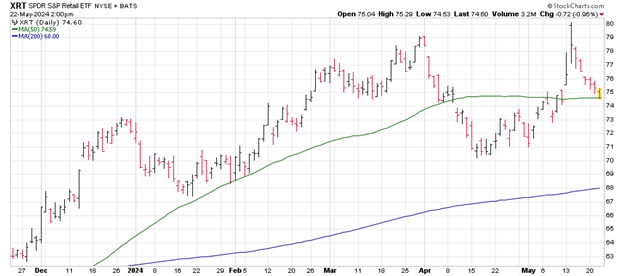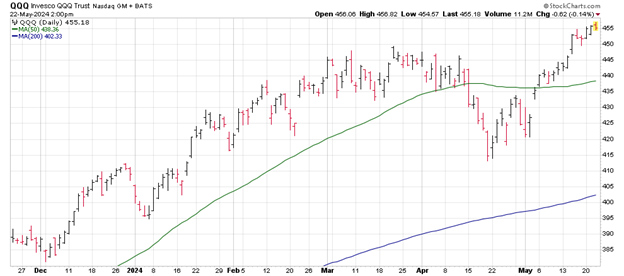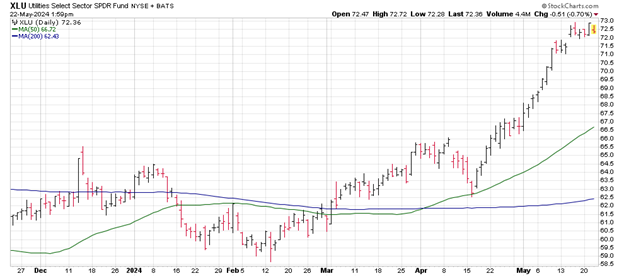Retail Earnings Reports
Retail earnings season is still in full swing with Target (TGT), TJX (TJX), and Williams-Sonoma (WSM) all dropping their earnings results on the market ahead of this morning’s opening bell.
Of the three, TJX is the only stock trading higher as the company is benefiting from an increase in bargain shoppers hitting the aisles. This is the same effect that bolstered Walmart’s outlook and stock price.
Williams-Sonoma shares are trading 7% lower, another sign that the higher-income shoppers are slowing their buying activity. Similarly, Target stock – a company that many like to think is a “discounter” is trading lower. The reason… they’re not really a discounter, they’re not Walmart (WMT).
The retail picture is a great indicator of where Americans think the economy is headed, and right now, that’s towards a recession.
It’s very tempting to short a few of these names right now, but the more consistent approach to turning the negative trend in the retailers into a profitable position in your portfolio is to check out put options on the SPDR S&P Retail ETF (XRT). I’m personally looking out to the September options to allow the building negative trend work in my favor over a longer-term period.
Fed Minutes at @ 2:00
We haven’t heard much from the Fed lately, but that will change this afternoon.
At 2:00 pm ET, the Fed will release the minutes from their lost recent meeting. We’re not expecting much from the details of the discussions between the Fed members, but the market would love to hear any hints that we could see lower rates before summer. It’s not likely to happen.
A quick look at the bond market suggests that the smartest money in the market is starting to hedge an even longer period before lower rates become a reality. The yield on 10-Year Treasuries started moving higher this week, which is usually a sign that the bond market is expecting rates to stay where they are or head higher.
Keep in mind that the Fed doesn’t like to be too active as we get close to the election in November. They maintain a “just the facts” posture to insure that they don’t become part of the political process.
Expect to see some volatility after the minutes are released, outside of that I’m expecting a relatively quiet day until the big event after 4:00 this afternoon
Nvidia Earnings
This is the big one. The market has been waiting with bated breath for Nvidia (NVDA)’s quarterly earnings report, set to be released after the closing bell this afternoon.
Expectations for the AI juggernaut’s earnings remain exceptionally high, putting it in the position of being a “make or break” report, not for the stock alone, but for the entire market.
The Nasdaq 100 is trading right at its all-time highs today after a 3% rally since last week. The rally has been broad, as names like Microsoft (MSFT) and Alphabet (GOOGL) have shot to new all-time highs, but the rest of the tech heavy index has been in a bit of a retreat.
Names like AMD (AMD), Amazon (AMZN), and Meta (META) are trading well below their highs. To me, that’s a signal that the market is trading on thinner ice than the average investor thinks.
That thin ice will be tested this afternoon as Nvidia releases those earnings results. A miss of any sort or an outlook that isn’t as impressive as last quarters will send Nvidia stock tumbling while knocking the legs out from under the Nasdaq 100’s new high rally.
Now that we know what’s moving the market, let’s look at one of the hottest sectors on Wall Street.
Today we’re going to look at one of the two sectors that every investor should consider for their portfolio, at least that’s my opinion. I’ll cover the second sector on Friday.
I’m going right past the semiconductor sector (SMH), the Nasdaq 100 ETF (QQQ) and even the materials sector – which has been on a tear because of the bullish gold and silver trade.
No, today we’re going to look at the other end. The boring end of the sector spectrum. Because that’s where a subtle outperformance is taking place, and it’s just the beginning for this sector ETF.
I’m talking about the Utilities sector ETF (XLU).
I know what you’re thinking, utilities are one of the most boring sectors in the market. Their businesses lack innovation and technology, which is why nobody buys them anymore.
I agree. Heck, I don’t even like to buy the “Electric Company” square in Monopoly. But in a tough game, it’ll win for you. And that’s what we’re heading into, a tough game in the market.
Investors have been buying utility companies up at a breakneck speed for the past month. Just look at shares of the beleaguered PG&E (PCG). They’re up 18% over the last 27 trading days on relatively high volume.
Duke Energy (DUK)? Duke shares are up 14$ over the same 27 days.
And the Utilities Select Sector SPDR Fund… a basket of 31 companies, has returned 16% for the same period.
The utilities are hot, and it’s not the reason that you are thinking they are.
Most investors think that the utility stocks are taking off because the companies are charging us more for their services.
That’s not the case. Sure, the higher rates bring in more revenue, but that money is being spent on aging infrastructure, higher regulatory fees, and higher expenses to generate their services.
The reason these stocks are moving higher is the simplest reason on Wall Street, there are more buyers than sellers, period. Well, that and interest rates.
A huge number of investors have been spoiled for the last year, and they know it. I’m talking about income investors.
Sure, the average investor has been complaining about the effects of inflation, but inflation also drove high yield bank accounts and CD rates into the 5%+ universe for the first time in decades. This made the income investors happy.
But those days are coming to an end soon. As of now, the Fed is expected to drop interest rates by 0.25% in September, and then again before the end of the year. It will mark the end of “easy money” and send trillions of dollars into the market foraging for high interest rates alternatives.
That’s where the utilities come in.
The utility trade as an income generator is one that dates back as far as the markets. Invest in a company or bond that spins off a nice yield and hope that your nest egg doesn’t get cracked by market volatility.
But most investors that I talk to look at one thing when they decide on an income investment, the yield. That’s it, nothing more, they just want to see that 5.5% or higher yield. That’s the only thing that appears to make the investment “good” for them.
They’re doing it wrong. I call this “losing money safely.
The relationship between dividend yield and stock price is set up to attract investors to stocks that may have them losing money safely. We’ll get into an educational talk about that soon, but for now you should know that the Utilities sector ETF (XLU) is not one of these yield traps.
With its 3% dividend yield, the XLU shares aren’t the highest or lowest yield out there, but it’s a solid yield based on what you’re getting. That dividend is paid on a quarterly basis.
What you’re getting is a basket of utility stocks. The basket approach reduces headline risk as well as any company specific risk.
This is the type of position that builds wealth over time and provides income to your account.
I’ll get into the long-term mechanics and outlook for the XLU next week. For now, let’s look at the chart and where I expect this market outperformer to go over the next three months.
XLU shares emerged from a long-term bear market trend in April as they traded back above their 20-month moving average.
This shift in the long-term trend came after the short-term trends turned bullish in early March with the 50-day moving average shifting into a bullish trend just after the faster moving 20-day moving average crossed above that same 50-day.
The crossover of the 20- above the 50-day is a bullish momentum signal that forecasts higher prices over the following three months.
At their current price of $72.50, XLU is preparing to move into new high territory fueled not only by the positive technicals, but also by the huge amount of sideline cash that is starting to migrate to higher dividend yielding investments.
This breakout is like what we witnessed in 2019 as interest rates started to fall. At that time, the break to new all-time highs was worth a 30% return over one year for the XLU shares.
The next three months will serve as the appetizer for that move as early investors begin to position, just waiting for the Fed to confirm their speculation. Over that period, my target price for the XLU sits at $80, 10% higher from their current prices.
Bottom Line
The Utility sector and XLU shares are set to benefit from a once in a decade migration of assets from the sidelines into high yielding investments. The low volatility/high return nature of this rally will attract even larger inflows as the second half of 2024 ushers in a lower interest rate environment.
About the Author
Chris Johnson (“CJ”), a seasoned equity and options analyst with nearly 30 years of experience, is celebrated for his quantitative expertise in quantifying investors’ sentiment to navigate Wall Street with a deeply rooted technical and contrarian trading style.






